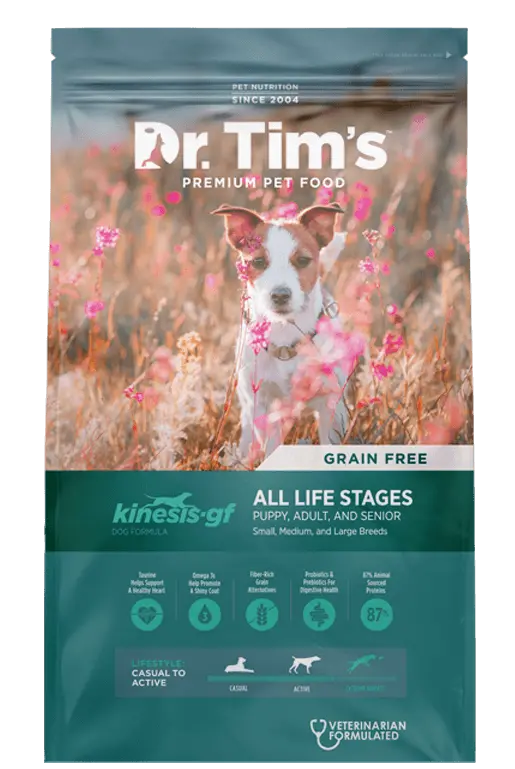
DogFoodAdvisor is reader supported See how
All reviews are 100% impartial but if you buy using links on this page, we may earn a referral fee.
Our Verdict
Dr. Tim’s Grain Free product range is made up of three recipes which each receive the Dog Food Advisor’s rating, 5 stars.
The table below shows each recipe in this range including our rating and the AAFCO nutrient profile: Growth (puppy), Maintenance (adult), All Life Stages, Supplemental or Unspecified.
| Product line | Rating | AAFCO |
|---|---|---|
| Dr. Tim's Kinesis Grain Free | 5 | A |
| Dr. Tim's Metabolite Grain Free | 5 | M |
| Dr. Tim's RPM Salmon & Pork Grain Free | 5 | A |
Recipe and Label Analysis
Dr. Tim’s Kinesis Grain Free was selected to represent the other products in the line for detailed recipe and nutrient analysis.
Dr. Tim's Kinesis Grain-Free
Estimated Dry Matter Nutrient Content
Protein
Fat
CarbsCarbohydrates
Chicken meal, peas, potatoes, chicken fat (preserved with mixed tocopherols), tapioca starch, dried plain beet pulp, egg product, catfish meal, herring meal, ground whole flaxseed, menhaden fish oil (preserved with mixed tocopherols), natural flavor, dicalcium phosphate, dried porcine plasma, salmon meal, vitamins (vitamin E supplement, l-ascorbyl-2-polyphosphate, biotin, niacin supplement, d-calcium pantothenate, riboflavin supplement, vitamin A supplement, thiamine mononitrate, pyridoxine hydrochloride, vitamin D3 supplement, vitamin B12 supplement, folic acid), potassium chloride, salt, lecithin (sunflower derived), minerals (zinc methionine complex, zinc sulfate, iron proteinate, ferrous sulfate, copper proteinate, copper sulfate, zinc proteinate, manganese proteinate, sodium selenite, manganous oxide, calcium iodate), dried kelp, taurine, dl-methionine, dried chicory root (source of inulin), choline chloride, l-lysine, psyllium seed husk, yucca schidigera extract, dried carrots, dried celery, dried beets, dried parsley, dried lettuce, dried watercress, dried spinach, dried golden algae, l-carnitine, dried bacillus coagulans fermentation product
Fiber (estimated dry matter content) = 4.5%
Red denotes any controversial items
| Estimated Nutrient Content | |||
|---|---|---|---|
| Method | Protein | Fat | Carbs |
| Guaranteed Analysis | 32% | 18% | NA |
| Dry Matter Basis | 36% | 20% | 36% |
| Calorie Weighted Basis | 30% | 40% | 30% |
Ingredients Analysis
The first ingredient in this dog food is chicken meal. Chicken meal is considered a meat concentrate and contains nearly 300% more protein than fresh chicken.
The second ingredient is dried potato, a dehydrated item usually made from the by-products of potato processing. In most cases, dried potato can contain about 10% dry matter protein which can affect our estimate of the total meat content of this recipe.
The next ingredient includes dried peas. Dried peas are a good source of carbohydrates. Plus they’re naturally rich in dietary fiber.
However, dried peas contain about 27% protein, a factor that must be considered when judging the actual meat content of this dog food.
The fourth ingredient is chicken fat. This item is obtained from rendering chicken, a process similar to making soup in which the fat itself is skimmed from the surface of the liquid.
Chicken fat is high in linoleic acid, an omega-6 fatty acid essential for life. Although it doesn’t sound very appetizing, chicken fat is actually a quality ingredient.
The fifth ingredient is tapioca, a gluten-free, starchy carbohydrate extract made from the root of the cassava plant.
The next ingredient is beet pulp. Beet pulp is a controversial ingredient, a high fiber by-product of sugar beet processing.
Some denounce beet pulp as an inexpensive filler while others cite its outstanding intestinal health and blood sugar benefits.
We only call your attention here to the controversy and believe the inclusion of beet pulp in reasonable amounts in most dog foods is entirely acceptable.
The seventh ingredient is dried egg product, a dehydrated form of shell-free eggs. Quality can vary significantly. Lower grade egg product can even come from commercial hatcheries — from eggs that have failed to hatch.
In any case, eggs are easy to digest and have an exceptionally high biological value.
The eighth ingredient is catfish meal, another protein-rich meat concentrate.
Fish meal is typically obtained from the “clean, dried, ground tissue of undecomposed whole fish and fish cuttings” of commercial fish operations.1
The ninth ingredient is herring meal, yet another high protein meat concentrate.
From here, the list goes on to include a number of other items.
But to be realistic, ingredients located this far down the list (other than nutritional supplements) are not likely to affect the overall rating of this Dr. Tim’s product.
With six notable exceptions…
First, we find flaxseed, one of the best plant sources of healthy omega-3 fatty acids. Provided they’ve first been ground into a meal, flax seeds are also rich in soluble fiber.
However, flaxseed contains about 19% protein, a factor that must be considered when judging the actual meat content of this dog food.
In addition, chicory root is rich in inulin, a starch-like compound made up of repeating units of carbohydrates and found in certain roots and tubers.
Not only is inulin a natural source of soluble dietary fiber, it’s also a prebiotic used to promote the growth of healthy bacteria in a dog’s digestive tract.
Next, we note the use of taurine, an important amino acid associated with the healthy function of heart muscle. Although taurine is not typically considered essential in canines, some dogs have been shown to be deficient in this critical nutrient.
Since taurine deficiency appears to be more common in pets consuming grain-free diets, we view its presence in this recipe as a positive addition.
This recipe also includes salmon meals, yet more high protein meat concentrates.
We also find sodium selenite in this food. Sodium selenite is a controversial form of the mineral selenium. Sodium selenite appears to be nutritionally inferior to the more natural source of selenium found in selenium yeast.
And lastly, this food contains chelated minerals, minerals that have been chemically attached to protein. This makes them easier to absorb. Chelated minerals are usually found in better dog foods.
Nutrient Analysis
Based on its ingredients alone, Dr. Tim’s Grain Free Dog Food looks like an above-average dry product.
The dashboard displays a dry matter protein reading of 36%, a fat level of 20% and estimated carbohydrates of about 36%.
As a group, the brand features an average protein content of 35% and a mean fat level of 16%. Together, these figures suggest a carbohydrate content of 41% for the overall product line.
And a fat-to-protein ratio of about 46%.
Which means this Dr. Tim’s product line contains…
Above-average protein. Near-average fat. And below-average carbs when compared to other dry dog foods.
Even when you consider the protein-boosting effect of the dried potato, peas and flaxseed, this looks like the profile of a kibble containing a liberal amount of meat.
Dr. Tim's Dog Food Recall History
The following automated list (if present) includes all dog food recalls related to Dr. Tim's through December 2025.
No recalls noted.
You can view a complete list of all dog food recalls since 2009 here.
Our Rating of Dr. Tim's Grain Free Dog Food
Dr. Tim’s Grain Free is a dry dog food using a generous amount of named meat meals as its dominant source of animal protein, thus receiving 5 stars.
Compare Dr. Tim's Grain Free Dog Food
How does Dr. Tim's Grain Free compare with The Dog Food Advisor's most recommended brands?
A Final Word
The Dog Food Advisor does not accept money, gifts, samples or other incentives in exchange for special consideration in preparing our reviews.
However, we do receive a referral fee from online retailers (like Chewy or Amazon) and from sellers of perishable pet food when readers click over to their websites from ours. This helps cover the cost of operation of our free blog. Thanks for your support.
For more information, please visit our Disclaimer and Disclosure page.







